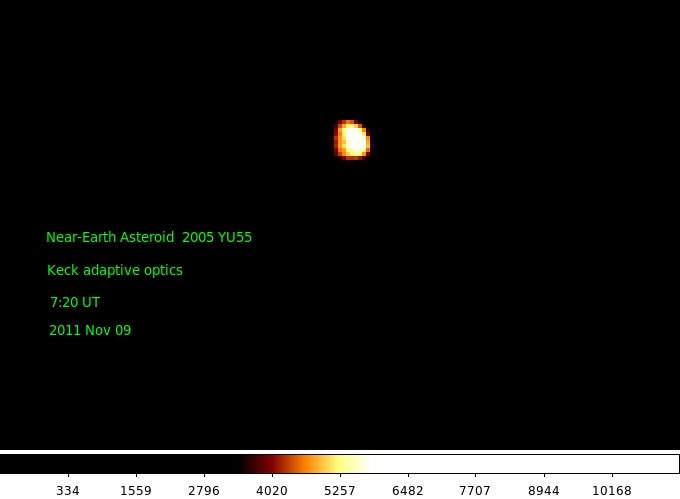Kamuela HI – One of the world’s largest optical/infrared telescopes has captured near-infrared light images of asteroid YU55 as it was departing its close flyby of Earth the night of Nov. 8, 2011. The observing run on the Keck II telescope was webcast live to a large audience on UStream directly from the Keck II Telescope Remote Operations room in Kamuela, Hawaii.
At the helm of the 10-meter telescope and using Keck’s pioneering adaptive optics to view YU55 were asteroid investigators William Merline and Peter Tamblyn of Southwest Research Institute, Boulder, Colo.; and Chris Neyman of Keck Observatory.
The first unprocessed infrared images of the coal-black asteroid appear to confirm that the asteroid does not have any small companion satellites and that it may be somewhat smaller than some researchers have suspected.
Asteroid YU55, made its closest approach to Earth – just 324,600 kilometers – on Nov. 8 at 3:26 pm U.S. PST. Merline’s research is funded by NASA’s Planetary Astronomy Program and NSF’s Planetary Astronomy Program. More updates and images are forthcoming.
# # #
The W. M. Keck Observatory operates two 10-meter optical/infrared telescopes on the summit of Mauna Kea on the Big Island of Hawaii. The twin telescopes feature a suite of advanced instruments including imagers, multi-object spectrographs, high-resolution spectrographs, integral-field spectroscopy and a world-leading laser guide star adaptive optics system which cancels out much of the interference caused by Earth’s turbulent atmosphere. The Observatory is a private 501(c) 3 non-profit organization and a scientific partnership of the California Institute of Technology, the University of California and NASA.


